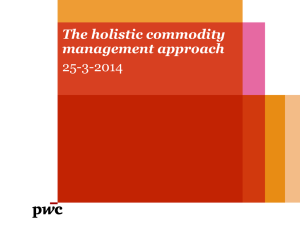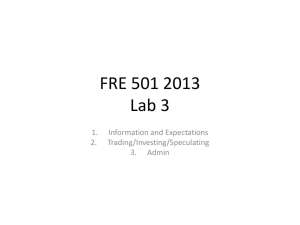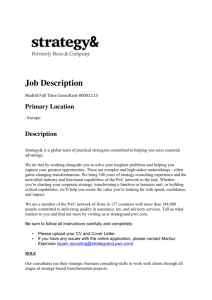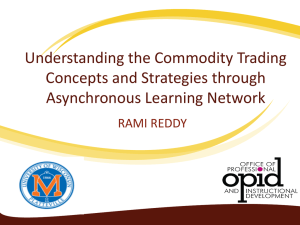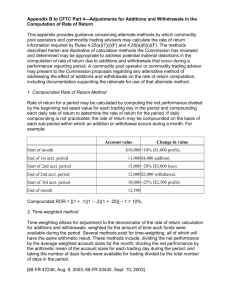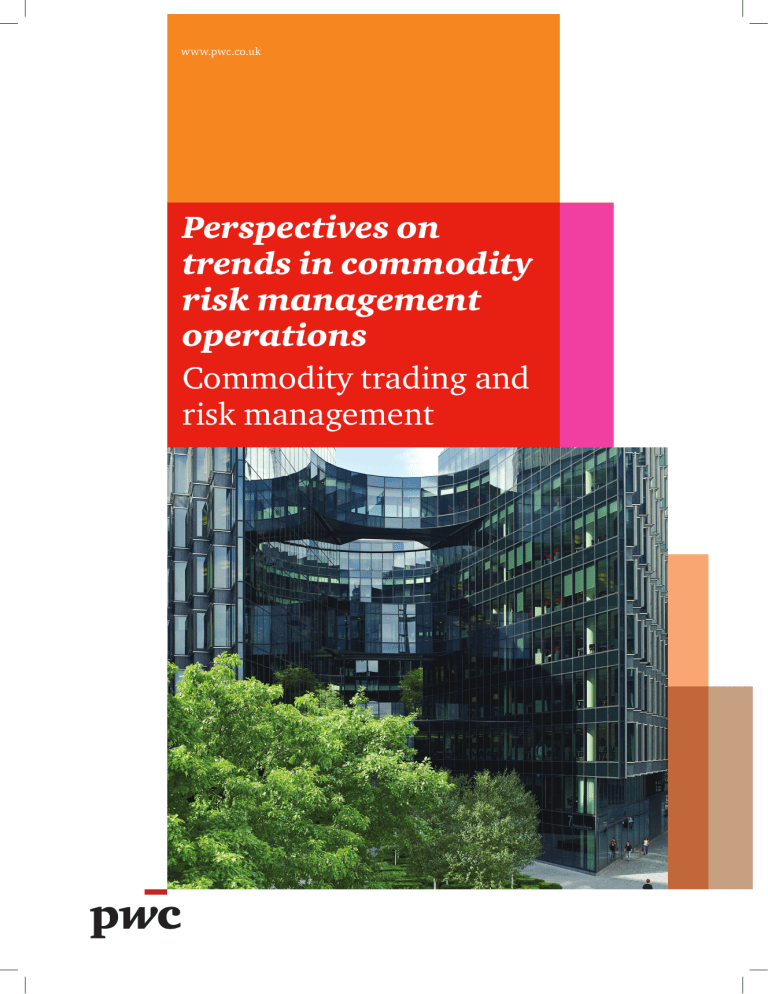
www.pwc.co.uk
Perspectives on
trends in commodity
risk management
operations
Commodity trading and
risk management
Content
Executive summary
1
Market Volatility – the challenge and opportunity
2
The importance of risk appetite
3
Trends in CTRM approach
4
The ‘Enterprise risk’ model
5
The ‘Risk to Profit’ advantage model
6
How we can help
7
Key contacts
9
Executive summary
Commodity risk management is emerging as a
critical differentiator of business performance
The ‘new normal’ is a world of significant commodity price volatility affecting many
businesses across different industry sectors and across the full value chain of their activities.
Many leading companies have established Commodity Trading and Risk Management (CTRM)
‘functions’ which are delivering significant performance and control improvements.
The leaders are someway down the path and are setting clear CTRM standards, others still
have a way to go.
Emerging standards in CTRM
External
challenges
Commodity
price
volatility
Regulatory,
Tax,
Accounting
compliance
Reputation
risk of
fraud and
control
lapses
Accessing
skilled staff
Systems
Operating model
Regulation
• Common data and
information
architectures
• Centralised CTRM
functions
• Regulatory capability
• Integrated package
applications
• Straight through
processing
• Supply chain and
procurement
optimised and
aligned to CTRM
activities
• Regular review of
impact on trading
strategy
• Extensive training
• Reporting directly
from systems
• Real time reporting
• Treasury aligned to
CTRM operations
Cost management
Risk management
Governance
• Supply chain
synergies
• Quantitative risk
measurement
• Rigorous anti-fraud
controls
• Lean/continuous
improvement culture
• Integrated scenario
planning
• Enhanced internal
audit role
• Back office through
captive SSC or
outsourcing
• Enterprise and
strategic risk
management
• Clear accountability
and decision
frameworks
Taxation
People
Internal control
• Transfer pricing
optimised
• Behaviours and
culture programme
• Segregation of duties
rigorously applied
• Indirect tax
exposures actively
managed
• Reward aligned to
corporate
performance
• Trading controls/
limits
• Location optimised
Internal
challenges
Showing the
value-add
of CTRM
activities
Setting
‘risk
appetite’
Structuring
governance
and control
Structuring
an efficient
operating
model
• Automated systems
controls
PwC view of emerging cross industry standards in CTRM
PwC | Perspectives on trends in commodity risk management operations | 1
Leading companies have responded to the
challenges and opportunities of market
volatility by setting up CTRM functions
Volatility* = 45%
Copper
10
5
0
2001 2003 2005 2007 2009 2011
Price ($/MT)
Price ($/Bushel)
15
Volatility* = 23%
Brent
Volatility* = 34%
200
12000
10000
8000
6000
4000
2000
0
Price ($/Barrel)
Wheat
2001 2003 2005 2007 2009 2011
150
100
50
0
2001 2003 2005 2007 2009 2011
Source: Bloomberg
Volatility – The management challenge
All companies are exposed to volatilities
in the commodities and financial
markets. These volatilities have increased
dramatically over the last 10 to 15 years
prompting significant developments in
the approach taken by many firms to
manage risk.
Commodity prices are by nature volatile.
The charts above illustrate the scale of
price volatilities in the Wheat, Copper
and Brent Crude markets since 2001.
Volatility is a consequence of market
supply and demand imbalances
combined with technical instabilities
caused by participants benefiting from
market inefficiencies. Such factors have
also led to a change in the nature of the
markets for many commodities.
Whilst the timing and impact of these
‘influencing’ factors may change,
increased volatility across different
commodities is here to stay.
Volatility needs to be actively managed
because the uncertainty and variability
it feeds directly into a company’s
financial performance attracts the
attention of external commentators.
It impacts cash flows and margin and
influences share price and market
reputation.
Challenges in setting up successful CTRM functions
Many companies have set up CTRM
operations as specialist functions with
the mandate to apply consistent
management practices across risks that
can be found in commodity supply and
marketing, credit and treasury. This
approach has delivered success
including; operational synergies, cost
savings and control benefits and the
potential for upside optimisation.
Creating this structure brings
challenges. Setting up a CTRM function
implies centralising aspects of the
commercial supply chain. In a business
with a strongly established centralised
management style, such change can be
relatively straightforward. However, in
a business with a more decentralised
management style, engaging the
support of local business ‘stakeholders’
to relinquish ownership of commercial
activities to a new function can be a
difficult cultural challenge. This
requires a well articulated benefits case
to support the change and a well defined
governance framework to set out how
the new CTRM function will operate
within the business.
It is also critical to ensure that the
objectives for the CTRM function are
aligned to the objectives for other areas
of the business for example, treasury
and procurement. Commodity and
currency risks need to be considered
2 | Perspectives on trends in commodity risk management operations | PwC
together in a CTRM context because
currency volatility remains a challenge
despite the structurally low level of
interest rates experienced since the
2008 banking crisis.
Procurement functions are frequently
challenged to reduce costs, rather than
manage or hedge the cost which is often
a mandate set for commodities. These
factors may cause competing objectives
across these functions, so it is important
to ensure that risk management practices
are aligned across the different risk
categories to avoid sub-optimisation.
Different CTRM approaches have been
adopted by companies influenced by their
appetite for risk
Industry approaches
to CTRM
The strategic importance and recognition
of CTRM varies significantly across
different industry sectors and this has
driven a variety of business responses to
managing this challenge.
The approaches adopted to commodity
price risk management vary by geography,
sector and even by participant within
sector. There is no ‘one size fits all’ rather
opportunities for all to learn from the
experiences of others cross sector and
cross geography. In the energy sector, for
example, where the commodity is the
core product, there are a wide range of
risk stances applied to managing the
underlying commodity exposures by
different companies. In other sectors, for
example retail and consumer goods
businesses, the growing awareness of the
importance of commodity risks has
created a significant re-focus on
commodity risk management practices,
with some taking significantly more
pro-active risk management stances to
optimise rather than simply ‘hedge’
underlying exposures.
Energy
In this sector the management of the
price volatility of the commodity and the
optimisation of supply with demand are
key to the overall performance of the
company. Organisations have
established centralised commodity
trading operations, optimising the value
of the physical flow of the commodity,
trading around the physical flows to add
further value, using financial derivatives
to manage exposures and in some
instances, holding proprietary trading
positions.
In these businesses, the trading
operation sits at the hub’of the company,
often holding ownership of the
commodity inventory and managing the
‘manufacturing’ and customer supply
activities to deliver value. Such
companies typically apply ‘active
trading’ strategies, managing the
underlying risks within defined limits
using tight governance and control
standards. Differentiation happens
through differences in ‘risk appetites’,
with some being active market makers,
some ‘hedgers’ and others structuring
more simplified risk and commercial
strategies. Banks have played a key role
in providing liquidity’ for these activities
in the energy markets. Some Investment
Banks and independent Trading Houses
have bought into physical assets to
support their trading activities; the
markets have become more ‘vertically
integrated’.
A further consequence of the banking
crisis, has been increasing pressures on
companies who have adopted a ‘trading’
approach to CTRM to provide greater
transparency of their activities to
regulators and agencies. New regulations
(particularly Dodd-Frank (DFA) in the
US, and MiFID, REMIT, MAD, EMIR and
other requirements in Europe) and new
accounting rules will require many
‘trading’ businesses to provide greater
visibility of their activities. Traders are
also faced with other potential
challenges. Higher credit costs, complex
tax rules, liquidity to cover expanded
exchange trading and a risk that Balance
Sheet reserves may become required to
support trading, highlight that
delivering a contribution by ‘trading’
doesn’t come without its complications.
Other sectors
In other industry sectors the models
are different. In the airline sector, for
example, energy price risk is often
managed by the central treasury
function, ‘hedging’ the exposures to
create some certainty of the cost to
the business.
Industrial, retail and consumer goods
businesses are now actively managing
commodity risks. It is becoming
common to see centralised risk
management ‘centres of excellence’ in
these businesses managing commodity
supply and price risks plus the underlying
currency and cash risks. Often, a
centralised risk management unit holds
this responsibility working closely with
the procurement and treasury functions.
Centralised risk management
model for Corporates
incorporating a Global
Procurement Company
(Gproco)
Gproco
Financial
hedging
centralisation
Risk management
committee determines
financial and physical risk
management strategy
within policy
Sale and ownership
Sale and ownership
OpCos
Risk management
unit
Commodity/FX/Cash
Gproco
Payment
(may be cashless)
Suppliers
Payment
Physical delivery of commodity
PwC | Perspectives on trends in commodity risk management operations | 3
The trend is towards an ‘Enterprise’ risk
approach with some taking more pro-active
risk ‘stances’
We see clear trends, both within and
across industry sectors, as to the
structures and approaches being taken
to managing commodity risks. This is
despite the fact that companies vary
significantly in their objectives and
rationale for managing such risks.
The start point for most companies is to
understand the underlying exposures of
the organisation, agree on a risk
management objective and then develop
appropriate policies and operating
standards to manage the risks in line
with the agreed objectives.
Typically, companies commence the
journey from a ‘Federated’ risk
management structure, where
commodity risks are managed locally
by different businesses, then progress to
an ‘Enterprise’ risk management
approach, enabling cost savings,
synergies and certain optimisation to
be achieved.
‘Federated’
risk management
Characteristics
• Commodity price risk
management responsibility
embedded in local business
functions and operations –
creating local specialisation.
• Limited global view of
commodity risks.
• Limited coordination of risk
management activities.
• Focus on risk transfer
and avoidance (e.g. fixed price
supply contracts).
• Risk processes within functions.
Just as treasury functions have become
largely ‘centralised’ over the past 20 years,
we are now seeing an increasing focus
on the centralisation of CTRM functions,
under an ‘Enterprise’ risk management
approach.
Within the energy sector, however, there
are companies who maintain a more
simplistic approach and maintain
volatility through their P/L accounts,
transacting under long dated, spot based
supply agreements.
At the top end of the spectrum, many of
the leading energy and power
businesses, where optimising the value
of the underlying commodity is core to
their business performance, have
developed their CTRM activities into
specialised trading functions leveraging
the underlying risks to generate profit
advantage (i.e. ‘Risk to Profit’
advantage).
Some of the characteristics associated
with these different approaches are
highlighted below.
‘Enterprise’
risk management
Characteristics
• Aggregated view of risks across all
subsidiary businesses.
• Risk appetite fully developed. Risk
policies and strategies in place
including natural hedging.
• Use of more sophisticated
financial instruments although
limited position taking. Hedge
accounting likely to be key.
• Centralised/co-ordinated
approach to risk management –
likely to be specialist function
aligned to the treasury and
procurement functions.
• Use of appropriate quantitative
measures – Sensitivities, CFAR,
VAR, RAROC, and the effect on
key business indicators.
• Use of commodity and treasury
management systems.
• Limited use of financial
instruments.
4 | Perspectives on trends in commodity risk management operations | PwC
‘Risk to Profit’
advantage
Characteristics
• Risk based performance
management to Supply, Trading
and Proprietary Books with clear
capital allocation.
• Real-time optimisation of physical
supplies, logistics and inventories
in line with market conditions.
• Risk based capital allocation and
decision taking.
• Risk management and trading
priorities fully aligned with
strategic objectives.
• Full front, middle and back office
capabilities enhanced with
commodity risk management
systems (packages and bespoke).
• Sophisticated modelling and
product control techniques to
enhance market positions.
• Strong compliance, tax and
accounting capabilities to meet
regulatory demands.
• Key control mechanisms in place.
Tax and Legal teams active in
support of trading activities.
Setting up for success under an ‘Enterprise’
risk model
Whether you are a sophisticated energy
trader or a new entrant into commodity
risk management, there are some
critical requirements to be addressed in
establishing CRTM operations to deliver
value to the business. In particular:
• Understanding the true nature of
your underlying risks, agreeing a risk
management strategy with
supporting policies and risk
valuation methodologies. This is all
about being clear on how the risk
function will add value. Additional
value considerations are the related
synergies from consolidating supply
chain activities around the CTRM
function.
• Understanding the regulatory,
accounting and tax factors which
might impact your commodity risk
management and supply chain strategy.
Failing to adequately address these
factors has led some businesses to
experience operational failures and
affected reputations with regulatory
authorities.
• Determining the appropriate
governance and control framework
for your CTRM activities. In
particular, understanding how the
CTRM function aligns with other
functions in the organisation (e.g.
treasury, procurement, supply chain,
etc.) and how decisions get taken.
• Defining a clear performance
management framework for the
CTRM function, driven potentially
by tax/transfer pricing considerations,
aligned to the wider performance
framework of the organisation.
• Implementing standard processes
and controls for each asset/trading
class, supported by appropriate
systems.
fail to adequately define the data/
information architecture and this leads
to sub-optimal decisions on the use of
supporting systems.
• Training and inducting staff;
creating behaviours which drive a
culture to reward based on meeting
business goals rather than individual
performance targets.
In the early days of CTRM activities,
many companies invested in bespoke
systems, today the trend is towards the
use of ‘best of breed’ package solutions.
There are now a range of established
packages providing full front/middle/
back office coverage. As an alternative,
certain of the leading ERP providers are
also moving into the CTRM market,
offering integrated physical/financial
trading and supply functionality with
back office accounting. For those
adopting an ‘Enterprise’ risk
management approach, certain treasury
management systems may offer a very
robust CTRM technology solution.
Challenges in moving to an
‘Enterprise’ risk approach
Strategy,
instruments
and risk
management
methodologies
Governance and
performance
management
Technology
and data
Process, people
and controls
Technology is a major cost factor in
CTRM operations. Setting a robust
information, data and systems
architecture with the flexibility to adjust
to your changing commodity risk
management and supply chain activities
is a critical success factor for all.
Timely, accurate and relevant data,
analysed and presented as user
information for front, middle and back
office staff, is critical for a high performing
CTRM function.
Underpinning the delivery of this
critical user information is the need for
a robust data and information
architecture which sets the framework
to determine the systems configuration
required to deliver the architecture. In
our experience, many CTRM functions
PwC | Perspectives on trends in commodity risk management operations | 5
Moving to a ‘Risk to Profit’ advantage model
offers significant potential upside but implies
greater overheads
For many companies, achieving an
‘Enterprise’ risk approach is the goal, but
for others a more active trading (i.e.
‘Risk to Profit’ advantage) approach is
the objective. Independent commodity
traders are an example of this group, but
many leading energy and power
companies also operate CTRM functions
to optimise physical supply, supply chain
and inventories in real-time response to
volatile market conditions and trade for
profit.
Operating as an active physical and
financial trading entity brings with it a
whole set of new internal and
external challenges.
Internal
Internally, more sophisticated risk
management methodologies, systems,
capital allocation and performance
management standards and supporting
technologies are likely to be required.
Understanding where and how value is
created across trading desks and books
is a challenge which becomes more
complicated as businesses expand both
geographically and in the range of risks
managed. Hence, clear definition is key.
The ‘operating model’ for the trading
business is another important internal
challenge. The ‘overhead’ of the Middle
and Back Office activities are part of the
costs of doing business as a trading
operation. Companies are increasingly
offshoring or outsourcing aspects of
these activities and locating to tax
advantaged jurisdictions to increase
value add.
External
Externally, a major factor is the
approach to be taken to managing the
new regulations. There are particular
parallels for CTRM businesses to be
drawn from the experience of financial
services organisations in managing the
challenges arising from the effects of
regulation.
The first key requirement is to
understand areas of ‘impact’ on the
business, then to determine the
response. Some trading companies are
looking to adopt ‘Regulation in the
Round’, by implementing common
standards to identify, track and report
trades using common data standards to
provide the flexibility in the business
systems to meet each of their regulatory
requirements.
Challenges in operating an
active trading business
Regulation
Technology
and data
Performance
‘identification’
Process, people
and controls
6 | Perspectives on trends in commodity risk management operations | PwC
As regulations become clearer, we
expect to see some companies modify
their trading activities to avoid the
implicit costs of the new requirements.
Accounting is another external
challenge. Whilst a Front Office may
view their commodity trading business
as traded risk and, therefore, would look
to value their positions on a fair value/
mark-to-market basis, there are
prescriptive accounting rules for
physical commodities. Getting the right
book structures in place for capturing
and valuing trades to meet the
requirements of both internal and
external reporting is a
frequent challenge.
Achieving hedge accounting is often a
key policy objective, particularly for
corporates. Changes in accounting rules
should facilitate this but remain complex
to interpret and apply.
Tax is another critical consideration for
a trading business. Physical trading
attracts indirect taxes, with different
regimes across different jurisdictions.
Understanding the impact and
obligations of tax legislation on the
business is critical. For example, holding
base metals in certain locations in a
warehouse can create a taxable
establishment and attract indirect tax.
Close working between the tax and
trading teams is an imperative.
Another external consideration is the
role of independent ‘watchdogs’. We are
seeing a rise in alleged price manipulation
in certain markets and this is a
challenge likely to be faced by many
traders as markets become ever more
scrutinised.
How we can help
We have a global network of over 200 CTRM
specialists who can bring insights and good practices
to your CTRM challenges
Strategy
Governance and control
Risk appetite, Capital/asset
allocation, Trading strategy, Supply
chain optimisation, Product design,
Contract structuring.
Product control, Fraud risk,
Accountability and decision
frameworks, Governance
frameworks.
Risk management
Operating model
Risk analysis and models, Policy,
Reporting, Valuation methods,
Risk metrics and limits.
Roles and responsibilities across the
business, Organisation (including
back/front office structures),
Location analysis, Entity structures,
Book structures, Talent,
Performance management
frameworks.
Strategy
and risk
management
Operating
model,
governance
and control
Technology and data
Data and systems architecture,
Data modelling, Systems strategy,
Package selection, implementation
and review, Programme and change
management.
Accounting
Technology,
data and
process
Accounting, tax
and regulatory
compliance
End to end process design,
Documentation, Training, Learn/
continuous improvement, Standards
and delivery models.
• Our Global CTRM practice comprises
of more than 200 dedicated
specialists with a wide range of
CTRM experience. Our teams
operate from our offices in the
Tax
Planning, Compliance and
reporting, Indirect and direct tax
structures, Personal tax.
Process
• PwC is the world’s largest
professional services firm, employing
more than 160,000 staff in over
150 countries. Our firm offers 3 core
services to our clients: Assurance
(Audit), Tax and Advisory. These
‘lines of service’ are aligned to
provide our clients with a fully
integrated service, where this is
required. We are proud to be the
leading firm in many of the
territories in which we serve.
Accounting standards, Financial
reporting, Audit.
Regulation
Compliance with European, US/DFA
and Asian legislation.
USA (Houston and Atlanta), UK,
The Netherlands, France,
Germany, Switzerland, Singapore
and Australia.
• Our CTRM team work with clients
to address issues in all commodity
markets and geographies: Oil/Gas,
Power, Metals and Soft commodities.
Our CTRM specialists have access to
the extensive breadth of additional
PwC services where these may be
required. Our team works particularly
closely with our Banking and Capital
Markets colleagues as their insights
are often valuable to our corporate
clients.
• Our CTRM team are drawn from a
wide ranging background and
include specialists with the following
skills: Trading strategy, Trading
operations, Product control,
Risk management, Regulation,
Accounting, Treasury management,
Taxation, Governance, Data and
Technology, Assurance and Control.
PwC | Perspectives on trends in commodity risk management operations | 7
8 | Perspectives on trends in commodity risk management operations | PwC
Contact details for our CTRM specialists
PwC has a team of global experts dealing with commodity trading
and risk management issues in the oil and gas, power, carbon,
agricultural commodities, metals, consumer products, industrial
products and mining industries.
UK
Contact details
David Knight
david.knight@uk.pwc.com
Richard French
richard.french@uk.pwc.com
Paul Ward
paul.ward@uk.pwc.com
David Stebbings
david.stebbings@uk.pwc.com
Mahul Raval
mahul.g.raval@uk.pwc.com
Konstantin Suplatov
konstantin.suplatov@uk.pwc.com
Jemma Denning
jemma.denning@uk.pwc.com
Australia
Dante Peel
dante.peel@au.pwc.com
France
Vincent Le Bellac
vincent.le.bellac@fr.pwc.com
Germany
Folker Trepte
folker.trepte@de.pwc.com
Singapore
Voon Hoe Chen
voon.hoe.chen@sg.pwc.com
Switzerland
Travis Randolph
travis.randolph@ch.pwc.com
The Netherlands
Pim Roest
pim.roest@nl.pwc.com
USA
Mark Allan Smith
mark.allan.smith@us.pwc.com
PwC | Perspectives on trends in commodity risk management operations | 9
This publication has been prepared for general guidance on matters of interest only, and does not constitute professional advice. You should not act upon the
information contained in this publication without obtaining specific professional advice. No representation or warranty (express or implied) is given as to the accuracy or
completeness of the information contained in this publication, and, to the extent permitted by law, PricewaterhouseCoopers LLP, its members, employees and agents
do not accept or assume any liability, responsibility or duty of care for any consequences of you or anyone else acting, or refraining to act, in reliance on the information
contained in this publication or for any decision based on it.
© 2013 PricewaterhouseCoopers LLP. All rights reserved. In this document, “PwC” refers to the UK member firm, and may sometimes refer to the PwC network. Each
member firm is a separate legal entity. Please see www.pwc.com/structure for further details.
121212-160040-LS-OS

